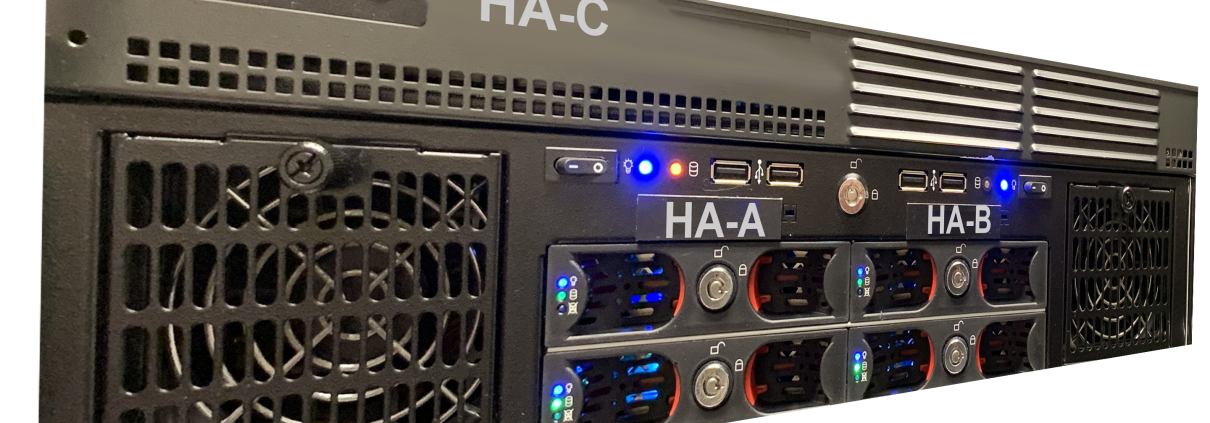One of the most important considerations when implementing clustered systems is ensuring that a cluster remains cohesive and stable given unexpected conditions. DRBD® already has fencing mechanisms and even a system of quorum, which is now capable of using a diskless arbitrator to break ties without requiring additional storage beyond that of two nodes.
Quorum and Fencing With a Healthy Dose of Reality
DRBD’s quorum implementation allows resources to vote on availability, taking into account connection state and disk state. While a DRBD cluster without quorum will allow promotion and writes on any node with “UpToDate” data, DRBD with quorum enabled adds the requirement that this node must also be in contact with either a majority of healthy nodes in the cluster, or a minimum amount of nodes as defined statically. This requires at least three nodes, and works best with odd numbers of nodes. A DRBD cluster with quorum enabled cannot become split-brain.
Fencing on the other hand, employs a mechanism to ensure node state by isolating or powering off a node in some way so that unhealthy nodes can be guaranteed to not provide services (by virtue of being assuredly offline). While the use case for fencing and quorum overlap by a large degree, fencing can automatically eject or recover misbehaving nodes, while quorum simply ensures that they cannot modify data.
It is possible to utilize scripts that are triggered in response to changes in quorum as a simple but effective fencing system via a “suicide” method — configuring a node to automatically reset or power itself off upon loss of quorum (accomplished via the “on-quorum-loss” handler in DRBD’s configuration). However, fully-fledged fencing methods via Pacemaker have much more logic behind them, can work even when the node to be fenced is entirely unresponsive, and make Pacemaker clusters “aware” of fencing actions.
The most important element to consider is that while both methods prevent split-brain conditions, quorum does not wholly and entirely replace out-of-band fencing. However, it comes extremely close, and in fact, close enough to eschew Pacemaker-based fencing in many configurations in favor of only quorum where fencing via privileged APIs (as is common in clouds) or dedicated fencing hardware (such as network PDUs or IPMI cards) is less than possible or desired.
Arbitrators!
Before now, in order for a DRBD resource to have three votes across three nodes for quorum, it needed three replicas of data. This was cost prohibitive in some scenarios, so additional logic was added to allow a diskless “arbitrator” node that does not participate in replication. Thusly, the diskless DRBD arbitrator was born.
The concept is fairly simple; rather than require a minimum of three replicas in a DRBD resource to enable quorum functionality, one can now use two replicas (or “data” nodes) with a third DRBD node in a permanently and intentionally diskless state as an “arbitrator” for breaking ties.
The same concepts of traditional DRBD quorum apply, with one significant exception: In a replica 2+A cluster, one node can be lost or disconnected without losing quorum — just like a replica 3 cluster. However, that arbitrator node cannot (on its own) participate in restoring quorum after it is lost.
The reason for this exception is simple: The arbitrator node has no disk. Without a disk, there is no way to independently determine whether data is valid, inconsistent, or related to the cluster at all because there is no data on that node to compare replicas with. While an arbitrator node cannot restore quorum to a single other inquorate data node, two data nodes may establish or re-establish quorum with each other. This is highly effective, and conquers the vast majority of quorum decisions at roughly 66% the cost of a replica 3 cluster.
Arbitrator Nodes in Action
I will not abide this level of grandstanding without a demonstration of this ability (and hopefully some revealing use cases), so below are some brief test results from a replica 2+A geo cluster. Behold:
root@geo-nfs-a:~# drbdadm status export-able
export-able role:Primary
disk:UpToDate
geo-nfs-b role:Secondary
peer-disk:UpToDate
geo-nfs-c role:Secondary
peer-disk:Diskless
As you can see, everything is happy. All of these nodes are connected and up to date. Nodes “geo-nfs-a” and “geo-nfs-b” are data nodes with disks. The node “geo-nfs-c” is a diskless DRBD arbitrator as well as a Booth arbitrator, and quorum has been enabled in this geo cluster (though that’s not reflected in this output). Geo clusters can be tricky to manage the datapath of, since they often operate outside of the scope of rapid decision-making mechanisms and even more often don’t have a method of fencing “sites” adequately. Using DRBD quorum in this case allows split-brains to be entirely prevented globally, rather than depending on several disconnected cluster controllers to manage things. This is much more stable, but requiring three sites with at least one full data replica each is very bandwidth-intensive as well as expensive. This is a perfect fit for an arbitrator node.
If we take one of the two data nodes offline, the cluster will still run. We’re still in contact with the arbitrator, and as long as we don’t lose that contact, quorum will be held:
root@geo-nfs-a:~# drbdadm status export-able
export-able role:Primary
disk:UpToDate
geo-nfs-b connection:Connecting
geo-nfs-c role:Secondary
peer-disk:Diskless
So let’s make it unhappy. If we take the majority of nodes offline this cluster will freeze, suspending I/O and protecting data from split-brain:
root@geo-nfs-a:~# drbdadm status export-able
export-able role:Primary suspended:quorum
disk:UpToDate quorum:no blocked:upper
geo-nfs-b connection:Connecting
geo-nfs-c connection:Connecting
Reconnecting only the arbitrator node will not result in a quorate cluster, as that arbitrator has no way of knowing whether that data node is actually valid:
root@geo-nfs-a:~# drbdadm status export-able
export-able role:Primary suspended:quorum
disk:UpToDate quorum:no blocked:upper
geo-nfs-b connection:Connecting
geo-nfs-c role:Secondary
peer-disk:Diskless
Connecting the peer data node will result in I/O resuming even if the arbitrator is still not functioning:
root@geo-nfs-a:~# drbdadm status export-able
export-able role:Primary
disk:UpToDate
geo-nfs-b-0 role:Secondary
peer-disk:UpToDate
geo-nfs-c connection:Connecting
Conclusion
I was able to use a Booth arbitrator node as a DRBD arbitrator node as well, both managing the cluster application state as well as securing the datapath against corruption with almost zero bandwidth usage beyond that of a 2N system. This is clearly a potent use-case and could not be more simple.
This new quorum mechanism could be applied identically to local high availability clusters, allowing reliable quorate systems to be established using a very low power third node. This can help to cheaply circumvent environmental problems that prevent adequate fencing, such as generic platform-agnostic deployment models, security-restricted environments, and even total lack of out-of-band fencing mechanisms (such as some public clouds or specialized hardware).
For posterity, the following DRBD configuration was used to accomplish this. Keep in mind, this was a geo cluster, so it’s using asynchronous replication (protocol A). Protocol C would be used for synchronous local replication:
# /etc/drbd.conf
global {
usage-count yes;
}
common {
options {
auto-promote yes;
quorum majority;
}
}
resource export-able {
volume 0 {
device minor 0;
disk /dev/drbdpool/export-able;
meta-disk internal;
}
on geo-nfs-a {
node-id 0;
address ipv4 10.1.0.100:7000;
}
on geo-nfs-b {
node-id 1;
address ipv4 10.2.0.100:7000;
}
on geo-nfs-c {
node-id 2;
volume 0 {
device minor 0;
disk none;
}
address ipv4 10.3.0.100:7000;
}
connection-mesh {
hosts geo-nfs-a geo-nfs-b geo-nfs-c;
net {
protocol A;
}
}
}


